An Energy-Equivalent d+/d− Damage Model with Enhanced Microcrack Closure-Reopening Capabilities for Cohesive-Frictional Materials
Abstract
:1. Introduction
- degradation of the elastic stiffness and softening response in the post-peak regime, with reduction of the peak strength for increasing deformation levels;
- non-symmetrical material behavior between tension and compression due to different strengths and different fracture energies;
- anisotropy induced in the material by the damage process, due to nucleation and evolution of planar microvoids “in the planar direction perpendicular to the maximum tensile strain” [26]. Hence, except for the case of hydrostatic stress or strain conditions, isotropic models are incomplete in the description of damage, which is intrinsically an anisotropic phenomenon [27] and drastically neglects the possibility of strut action in the assessment of the structural capacity [28];
- microcrack closure-reopening (MCR) effects, i.e., partial or total stiffness recovery in the transition from tension to compression, crucial in cyclic conditions, experimentally documented for concrete in [29].
Notation
2. Original d+/d− Damage Model
2.1. Strain Equivalence and Constitutive Law
- with concordant sign ( or ): isotropy is preserved after damage, and an isotropic (tensile or compressive, respectively) damage model is recovered.
- with discordant sign: the damaged material is anisotropic, and the directions of maximum and minimum axial stiffnesses are coincident with the principal directions of the effective stress tensor. As observed in [31,32], the coaxiality between the reference system of the anisotropic material and the principal directions of the nominal strain ε is a particular condition in anisotropic elasticity, which corresponds to the extremization of the strain energy density. In addition, the maximization or minimization of the strain energy density implies the coaxiality between the nominal strain tensor ε and the nominal stress tensor σ. These observations lead to assert that the d+/d− formulation can be interpreted within the rotating smeared crack concept, due to the co-rotation of the axes of material anisotropy with the principal axes of the strain ε, which consequently coincide also with the principal axes of the stress σ.
2.2. Discussion on Different Secant Stiffness Operators Based on Strain Equivalence
3. New d+/d− Damage Model Based on Energy Equivalence
3.1. Consistent Secant Stiffness for the Damage-Induced Orthotropy
3.2. Thermo-Dynamic Framework
3.3. Damage Criterion for Cohesive-Frictional Materials and Damage Evolution Laws
3.4. Algorithm for the d+/d− Damage Model
4. Multidirectional d+/d− Damage Model for Cyclic Loadings
4.1. Limitations of the Original d+/d− Formulation
4.2. Multidirectional Procedure
4.3. 3D Extension of the Multidirectional Procedure
4.4. Algorithms for the Multidirectional d+/d− Damage Model
- “Damage multidirectional saving (θ)” allows one to keep permanent memory of the damage orientation, assigning a tensile (compressive) damage value to a certain region depending on the maximum (minimum) principal strain direction that has generated it;
- “Damage multidirectional updating (θ)” provides the active damage values and the corresponding active damage thresholds, computed with reference to the current principal strain directions and the current equivalent stress quantities τ±(Equations (40) and (41));
- “Bisectors updating (θ)”, useful in the presence of cyclic load Type (ii), modify the bisectors and the amplitudes of the damage regions, according to Condition (54), when and .
5. Enhanced Capabilities of the New Multidirectional d+/d− Damage Model
5.1. Enhanced Representation of the Damage-Induced Orthotropy
5.2. Enhanced MCR Effects under Cyclic Loading
6. Conclusions
- the description of the orthotropy induced in the material by the degradation process is achieved by means of a consistent secant stiffness operator, whose definition is explicitly provided. To do this, the strain equivalence assumption considered in the original model is abandoned in favor of an energy-equivalent formulation, which yields both symmetry and positive definiteness in the constitutive matrix (Equation (23)). Further confirmation of the adequacy of this procedure in representing that the damage-induced orthotropy can be found in the analogy between the energy-equivalent framework and the tensor mapping procedure adopted in [35] for modelling an orthotropic behavior. From a mechanical point of view, the effects of the new d+/d− formulation are especially visible in the lateral deformation behavior of the material, whose relevance has been generally overlooked in damage mechanics; specifically, its adoption permits simulating a reduction of Poisson’s ratio throughout the damage process, rather than considering it unrealistically constant. Moreover, having an explicit version of the secant stiffness matrix, which lacks in the original formulation, is beneficial in computational terms since it allows the implementation of the secant Picard method.
- Microcrack closure-reopening effects are taken into account in the presence of generic cyclic conditions, especially under shear, making the model suitable for dealing with seismic actions. In fact, the impossibility of maintaining the memory of the damage directionality, due to the adoption of only the scalar variables d+ and d−, is overcome with the formulation of a “multidirectional” damage model. According to this procedure, a partition of the plane (2D problems) into two regions for tensile damage and two regions for compressive damage is performed, in order to monitor separately two damage values in tension and two damage values in compression, differing for the direction in which they act. The active d+ (d−) is chosen between these two tensile (compressive) damage values on the basis of the current principal directions. Moreover, the distinction between two different cyclic conditions, i.e., cyclic loadings considered alone (Type Load (i)) or preceded by not-cyclic permanent loads (Type Load (ii)) and the proposal of an ad hoc procedure for each of them add versatility to the formulation, since after loading reversal, a complete stiffness recovery, no stiffness recovery and even a partial stiffness recovery can be modelled, as demonstrated in the problem of the shear panel.
Acknowledgments
Author Contributions
Conflicts of Interest
Appendix A
- In pure shear conditions (trε+ = −trε−, ε+:ε+ = (trε+)2 =ε−:ε− = (trε−)2, d+ ≠ 0, d− ≠ 0), the positiveness of the quantities contained in Equations (A5) and (A6) translates in the following inequalities, respectively:Considering the typical mechanical parameters of a cohesive-frictional material, such as concrete or masonry, these relations among the damage variables, strictly related to the fracture energies in tension and compression (see Equations (44), (45) and (47)), are always satisfied.
- In the case of uniaxial tensile load in Direction 1 (trε+ = ε1 and , d+ ≠ 0, d− = 0), the quantity contained in Equation (A5) is always positive and can be expressed in the following way:The same results can be obtained for the case of uniaxial compressive load (d+ = 0 and d− ≠ 0).
- Although the quantity is in the denominator in Equation (A5), in the case of d+ close to one, the work done by in Equation (32) remains bounded, specifically tends to be null, because in that situation, tends to zero. An analogous consideration holds for the work performed by when d− is close to one.
References
- Comi, C.; Perego, U. Fracture energy based bi-dissipative damage model for concrete. Int. J. Solids Struct. 2001, 38, 6427–6454. [Google Scholar] [CrossRef]
- Faria, R.; Oliver, J.; Cervera, M. A strain-based plastic viscous-damage model for massive concrete structures. Int. J. Solids Struct. 1998, 35, 1533–1558. [Google Scholar] [CrossRef]
- Mazars, J.; Pijaudier-Cabot, G. Continuum damage theory- Application to concrete. J. Eng. Mech. 1989, 115, 345–365. [Google Scholar] [CrossRef]
- Papa, E.; Taliercio, A. Anisotropic damage model for the multiaxial static and fatigue behaviour of plain concrete. Eng. Fract. Mech. 1996, 55, 163–179. [Google Scholar] [CrossRef]
- Cervera, M.; Oliver, J.; Faria, R. Seismic evaluation of concrete dams via continuum damage models. Earthq. Eng. Struct. Dyn. 1995, 24, 1225–1245. [Google Scholar] [CrossRef]
- He, W.; Wu, Y.F.; Xu, Y.; Fu, T.T. A thermodynamically consistent nonlocal damage model for concrete materials with unilateral effects. Comput. Methods Appl. Mech. Eng. 2015, 297, 371–391. [Google Scholar] [CrossRef]
- Ortiz, M. A constitutive theory for the inelastic behaviour of concrete. Mech. Mater. 1985, 4, 67–93. [Google Scholar] [CrossRef]
- Simo, J.C.; Ju, J.W. Strain- and stress-based continuum damage models-I. Formulation. Int. J. Solids Struct. 1987, 23, 821–840. [Google Scholar] [CrossRef]
- Simo, J.C.; Ju, J.W. Strain- and stress-based continuum damage models-II. Computational Aspects. Int. J. Solids Struct. 1987, 23, 841–869. [Google Scholar] [CrossRef]
- Lubliner, J.; Oliver, J.; Oller, S.; Oňate, E. A plastic-damage model for concrete. Int. J. Solids Struct. 1989, 25, 299–326. [Google Scholar] [CrossRef]
- Ju, J.W. On energy-based coupled elastoplastic damage theories: Constitutive modelling and computational aspects. Int. J. Solids Struct. 1989, 25, 803–883. [Google Scholar] [CrossRef]
- Wu, J.Y.; Li, J.; Faria, R. An energy rate-based plastic-damage model for concrete. Int. J. Solids Struct. 2006, 43, 583–612. [Google Scholar] [CrossRef]
- Contraffato, L.; Cuomo, M. A framework of elastic–plastic damaging model for concrete under multiaxial stress states. Int. J. Plast. 2006, 22, 2272–2300. [Google Scholar] [CrossRef]
- Voyiadjis, G.Z.; Taqieddin, Z.N.; Kattan, P.I. Anisotropic damage-plasticity model for concrete. Int. J. Plast. 2008, 24, 1946–1965. [Google Scholar] [CrossRef]
- Lemaitre, J.; Chaboche, J.L. Aspects phènomènologiques de la rupture par endommagement. J. Mec. Appl. 1978, 2, 317–365. [Google Scholar]
- Cordebois, J.P.; Sidoroff, F. Endommagement anisotrope en elasticité et plasticité. J. Mec. Theor. Appl. 1982, Special Volume, 45–60. [Google Scholar]
- Carol, I.; Rizzi, E.; Willam, K. On the formulation of anisotropic elastic degradation. I. Theory based on a pseudo-logarithmic damage tensor rate. Int. J. Solids Struct. 2001, 38, 491–518. [Google Scholar] [CrossRef]
- Faria, R.; Oliver, J. A Rate Dependent Plastic-Damage Constitutive Model for Large Scale Computations in Concrete Structures; CIMNE Monograph No. 17; CIMNE: Barcelona, Spain, 1993. [Google Scholar]
- Cervera, M.; Oliver, J.; Manzoli, O. A rate-dependent isotropic damage model for the seismic analysis of concrete dams. Earthq. Eng. Struct. Dyn. 1996, 25, 987–1010. [Google Scholar] [CrossRef]
- Faria, R.; Oliver, J.; Cervera, M. Modelling Material Failure in Concrete Structures under Cyclic Actions. J. Struct. Eng.-ASCE 2004, 130, 1997–2005. [Google Scholar] [CrossRef]
- Silva, B.Q.; Pappas, A.; Guedes, J.M.; da Porto, F.; Modena, C. Numerical analysis of the in-plane behaviour of three-leaf Stone masonry panels consolidate with grout injection. Bull. Earthq. Eng. 2017, 15, 357–383. [Google Scholar] [CrossRef]
- Petracca, M.; Pelà, L.; Rossi, R.; Oller, S.; Camata, G.; Spaccone, E. Multiscale computational first order homogenization of thick shells for the analysis of out-of-plane loaded masonry walls. Comput. Methods Appl. Mech. Eng. 2017, 315, 273–301. [Google Scholar] [CrossRef]
- Roca, P.; Cervera, M.; Pelà, L.; Clemente, R.; Chiumenti, M. Viscoelasticity and Damage Model for Creep Behaviour of Historical Masonry Structures. Open Civ. Eng. J. 2012, 6, 188–199. [Google Scholar] [CrossRef]
- Pelà, L.; Cervera, M.; Roca, P. Continuum damage model for orthotropic materials: Application to masonry. Comput. Methods Appl. Mech. Eng. 2011, 200, 917–930. [Google Scholar] [CrossRef]
- Pelà, L.; Cervera, M.; Roca, P. An orthotropic damage model for the analysis of masonry structures. Constr. Build. Mater. 2013, 41, 957–967. [Google Scholar] [CrossRef]
- Krajcinovic, D.; Fonseka, G.U. The continuous damage theory of brittle materials. J. Appl. Mech. 1981, 48, 809–824. [Google Scholar] [CrossRef]
- Wu, J.Y.; Li, J. On the mathematical and thermodynamical descriptions of strain equivalence based anisotropic damage model. Mech. Mater. 2008, 40, 377–400. [Google Scholar] [CrossRef]
- De Borst, R. Fracture in quasi-brittle materials: A review of continuum damage-based approaches. Eng. Fract. Mech. 2002, 69, 95–112. [Google Scholar] [CrossRef]
- Reinhardt, H.W. Fracture mechanics of an elastic softening material like concrete. HERON 1984, 29, 1–42. [Google Scholar]
- Faria, R.; Oliver, J.; Cervera, M. On Isotropic Scalar Damage Models for the Numerical Analysis of Concrete Structures; Publication CIMNE No. 198; CIMNE: Barcelona, Spain, 2000. [Google Scholar]
- Cowin, S.C. Optimization of the strain energy density in linear anisotropic elasticity. J. Elasticity 1994, 34, 45–68. [Google Scholar] [CrossRef]
- Pedersen, P. On optimal orientation of orthotropic materials. Struct. Optim. 1989, 1, 101–106. [Google Scholar] [CrossRef]
- Carol, I.; Willam, K. Spurious Energy Dissipation/Generation in Stiffness Recovery Models for Elastic Degradation and Damage. Int. J. Solids Struct. 1996, 33, 2939–2957. [Google Scholar] [CrossRef]
- Wu, J.Y.; Xu, S.L. Reconsideration on the elastic damage/degradation theory for the modelling of microcrack closure-reopening (MCR) effects. Int. J. Solids Struct. 2013, 50, 795–805. [Google Scholar] [CrossRef]
- Pelà, L.; Cervera, M.; Oller, S.; Chiumenti, M. A localized mapped damage model for orthotropic materials. Eng. Fract. Mech. 2014, 124, 196–216. [Google Scholar] [CrossRef]
- Lubliner, J. On the thermodynamics foundations of nonlinear solid mechanics. Int. J. Nonlinear Mech. 1972, 7, 237–254. [Google Scholar] [CrossRef]
- Coleman, B.D.; Gurtin, M.E. Thermodynamics with internal state variables. J. Chem. Phys. 1967, 47, 597–613. [Google Scholar] [CrossRef]
- Saloustros, S.; Pelà, L.; Cervera, M.; Roca, P. Finite Element Modelling of Internal and Multiple Localized Cracks. Computat. Mech. 2017, 59, 299–316. [Google Scholar] [CrossRef]
- Cervera, M. Viscoelasticity and Rate Dependent Continuum Damage Models; CIMNE Monograph No. 79; CIMNE: Barcelona, Spain, 2003. [Google Scholar]
- Bažant, Z.P.; Oh, B.H. Crack band theory for fracture of concrete. Mater. Struct. 1983, 16, 155–177. [Google Scholar] [CrossRef]
- Oliver, J. A consistent characteristic length for smeared cracking models. Int. J. Numer. Meth. Eng. 1989, 28, 461–474. [Google Scholar] [CrossRef]
- Caboche, J.L. Damage induced anisotropy: On the difficulties associated with the active/passive unilateral condition. Int. J. Damage Mech. 1992, 1, 148–171. [Google Scholar] [CrossRef]
- Rots, J.G.; Blaauwendraad, J. Crack models for concrete: Discrete or smeared? Fixed, multi-directional or rotating? HERON 1989, 34, 1–59. [Google Scholar]
- Rashid, Y. Analysis of prestressed concrete pressure vessels. Nucl. Eng. Des. 1968, 7, 334–344. [Google Scholar] [CrossRef]
- Rots, J.G.; Nauta, P.; Kusters, G.M.A.; Blaauwendraad, J. Smeared crack approach and fracture localization in concrete. HERON 1985, 30, 1–48. [Google Scholar]
- Wu, J.Y.; Cervera, M.; Jin, X.Y. Strain localization analysis of elastic-damaging frictional-cohesive materials: Analytical results and numerical verification. Materials 2017. submitted. [Google Scholar]
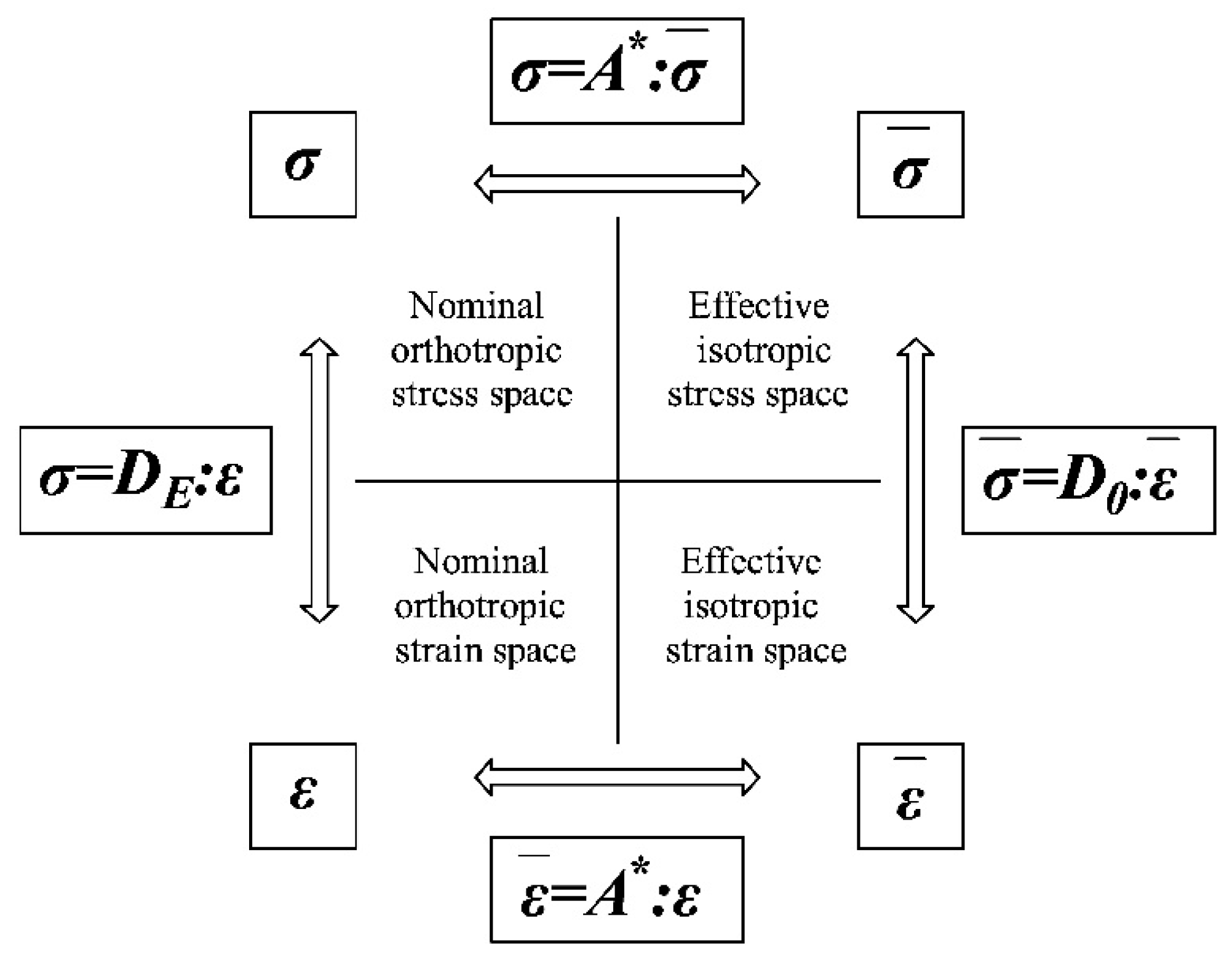

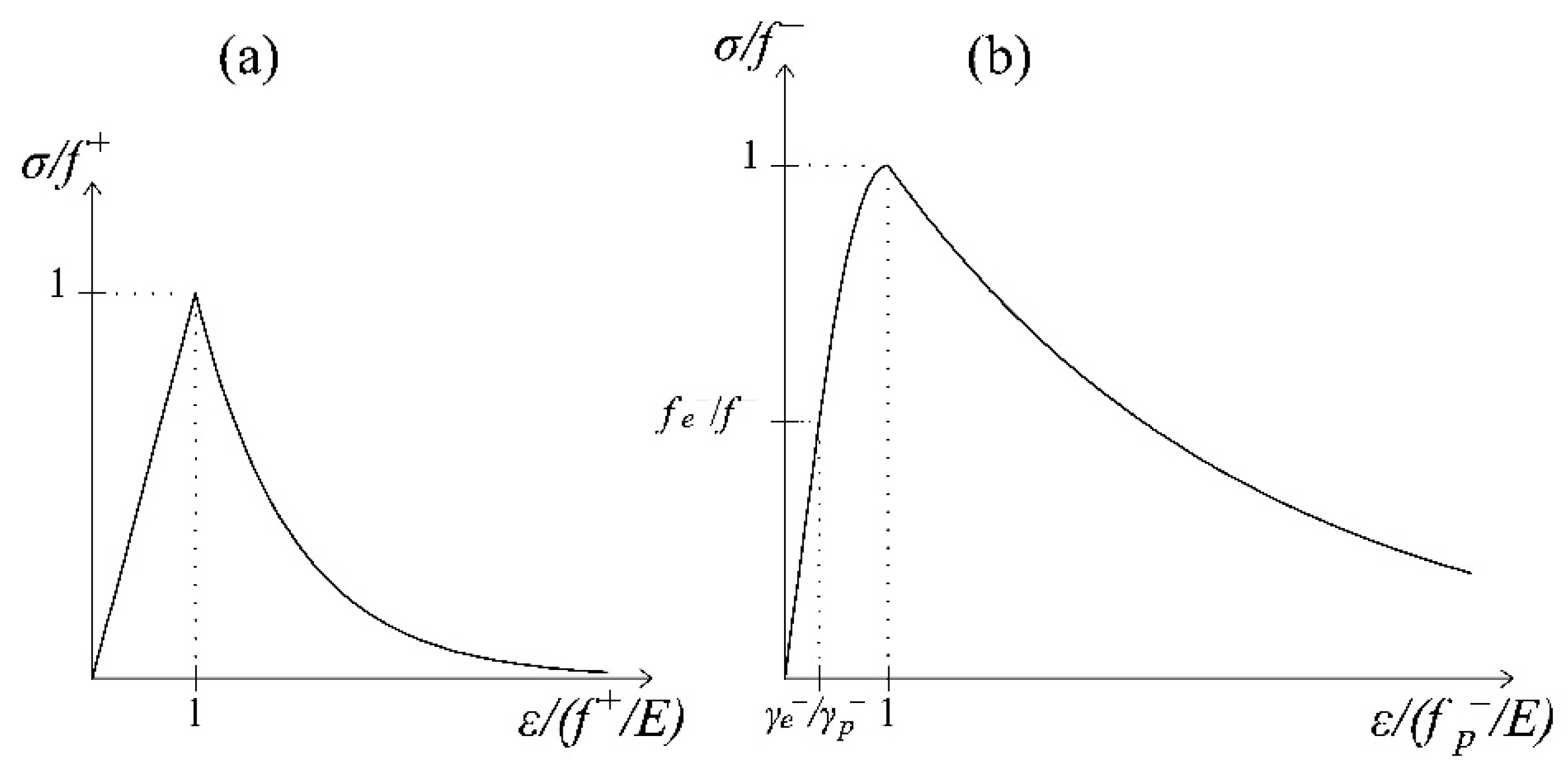
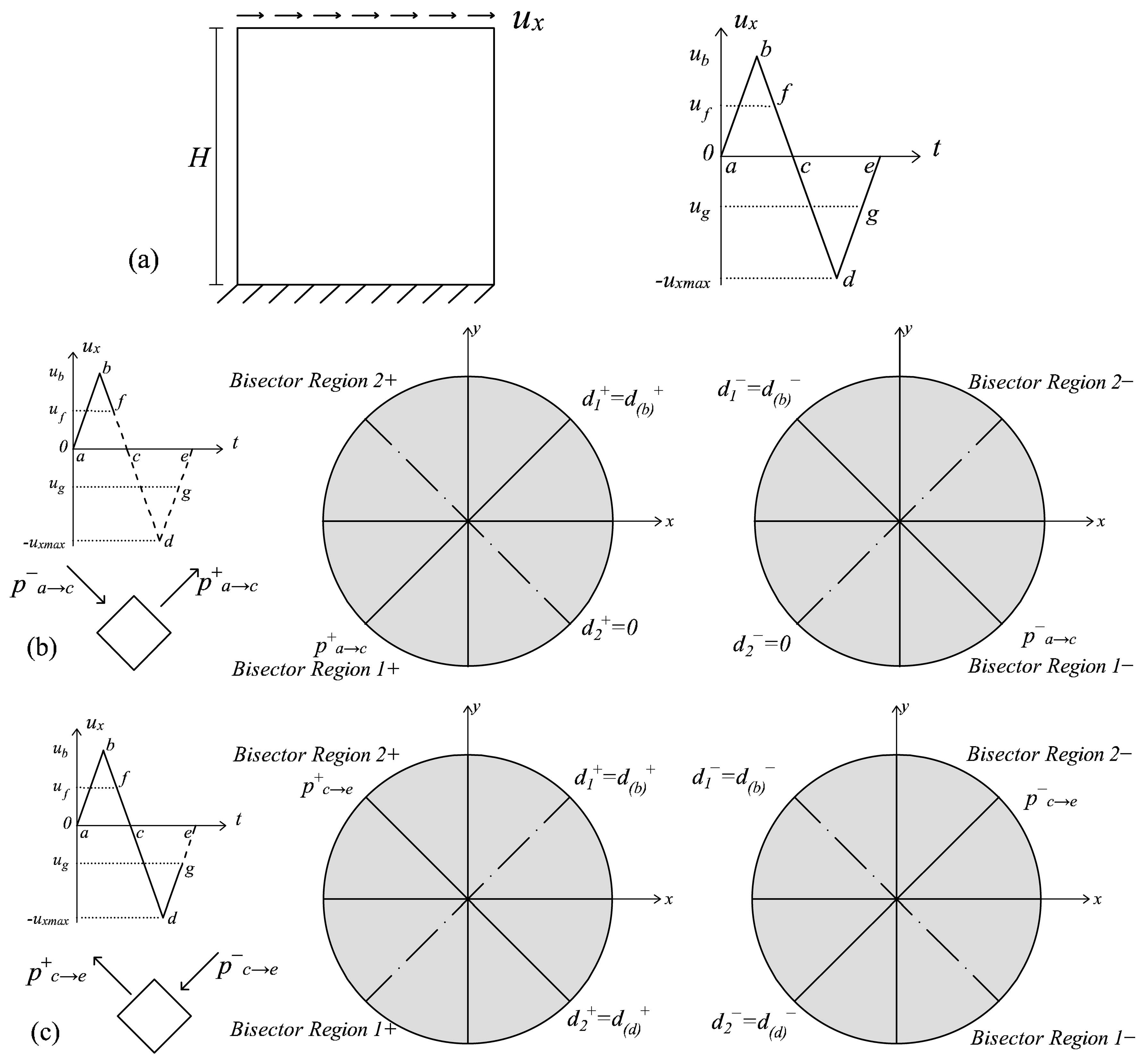
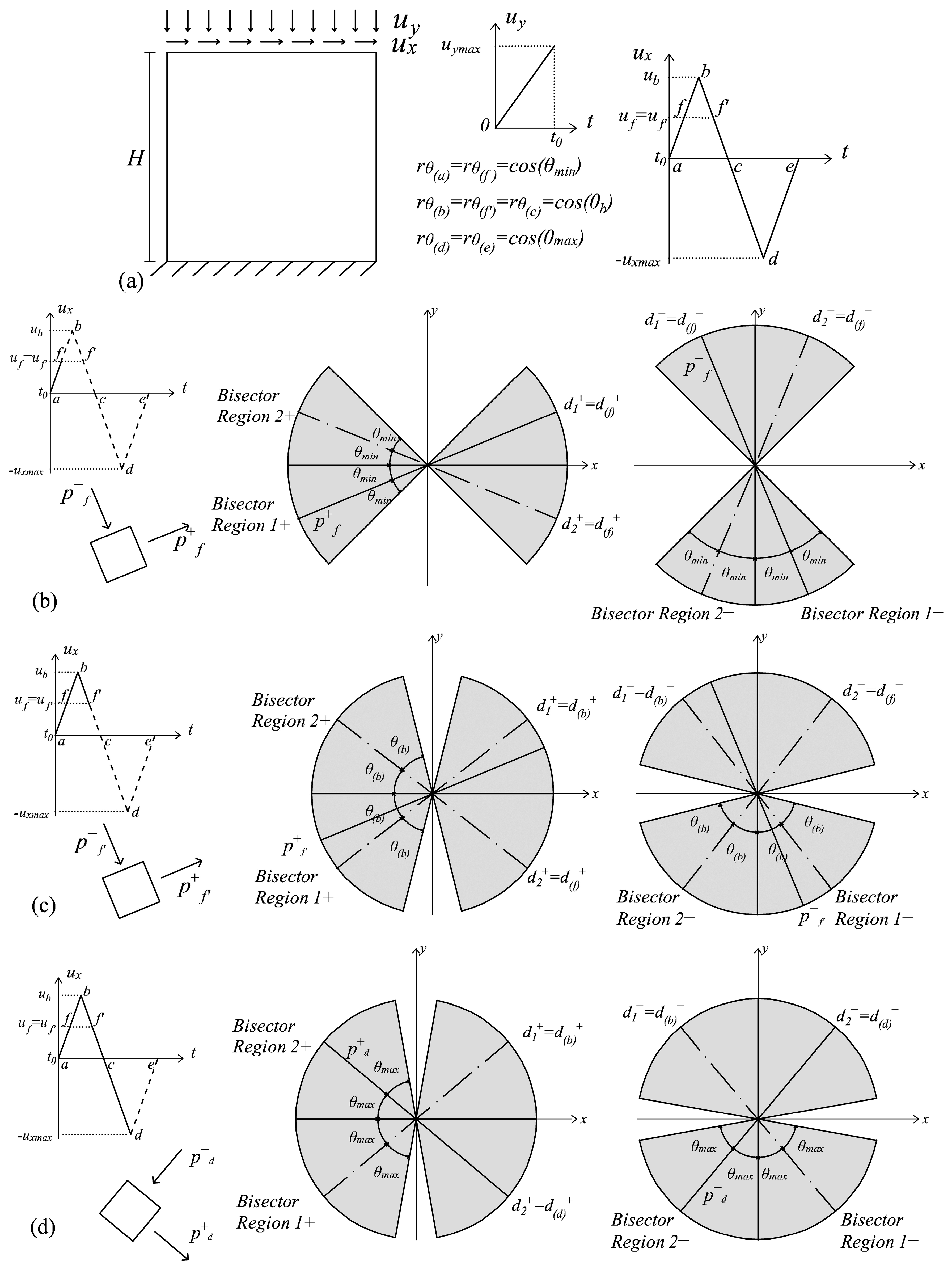
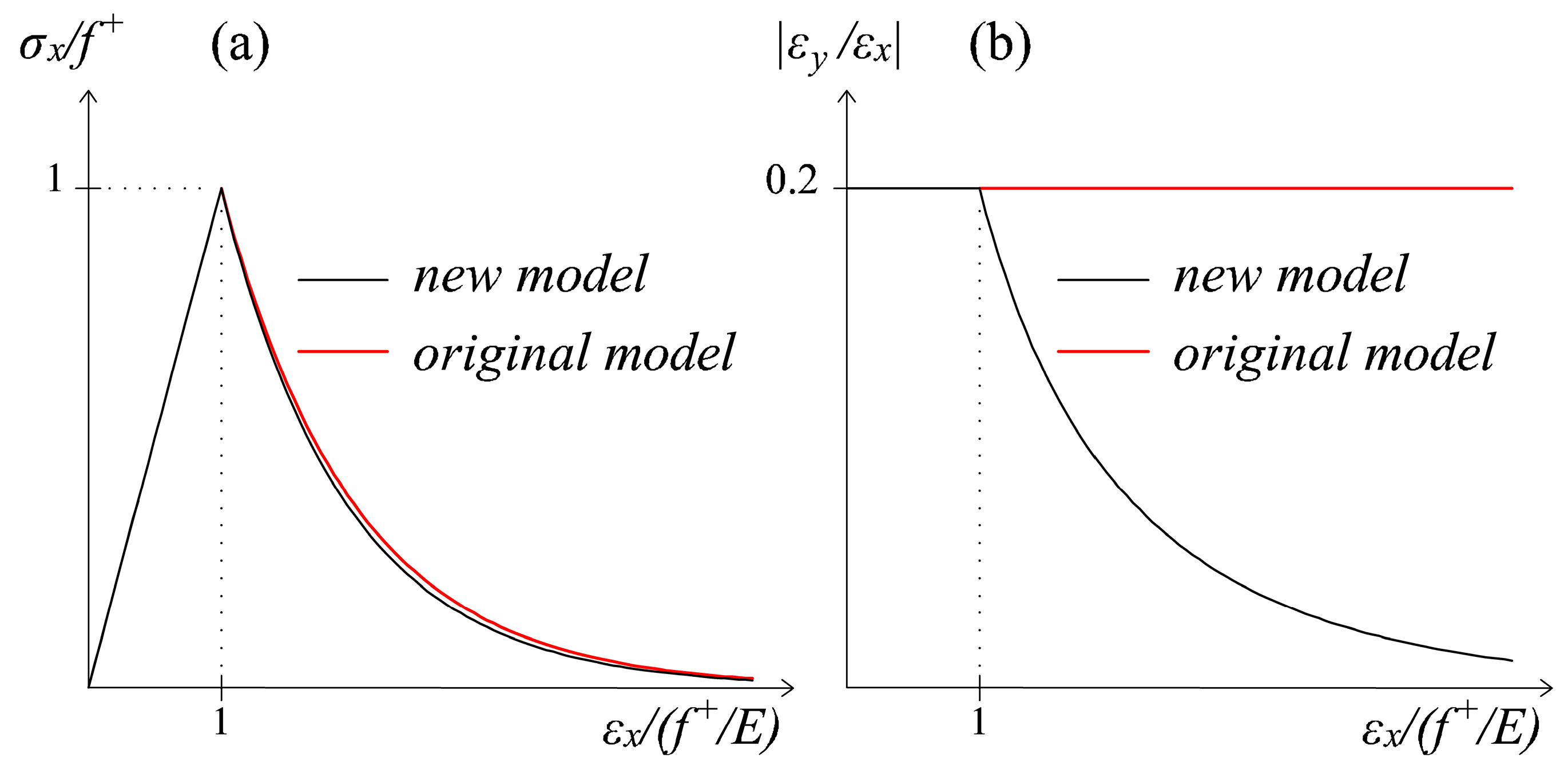
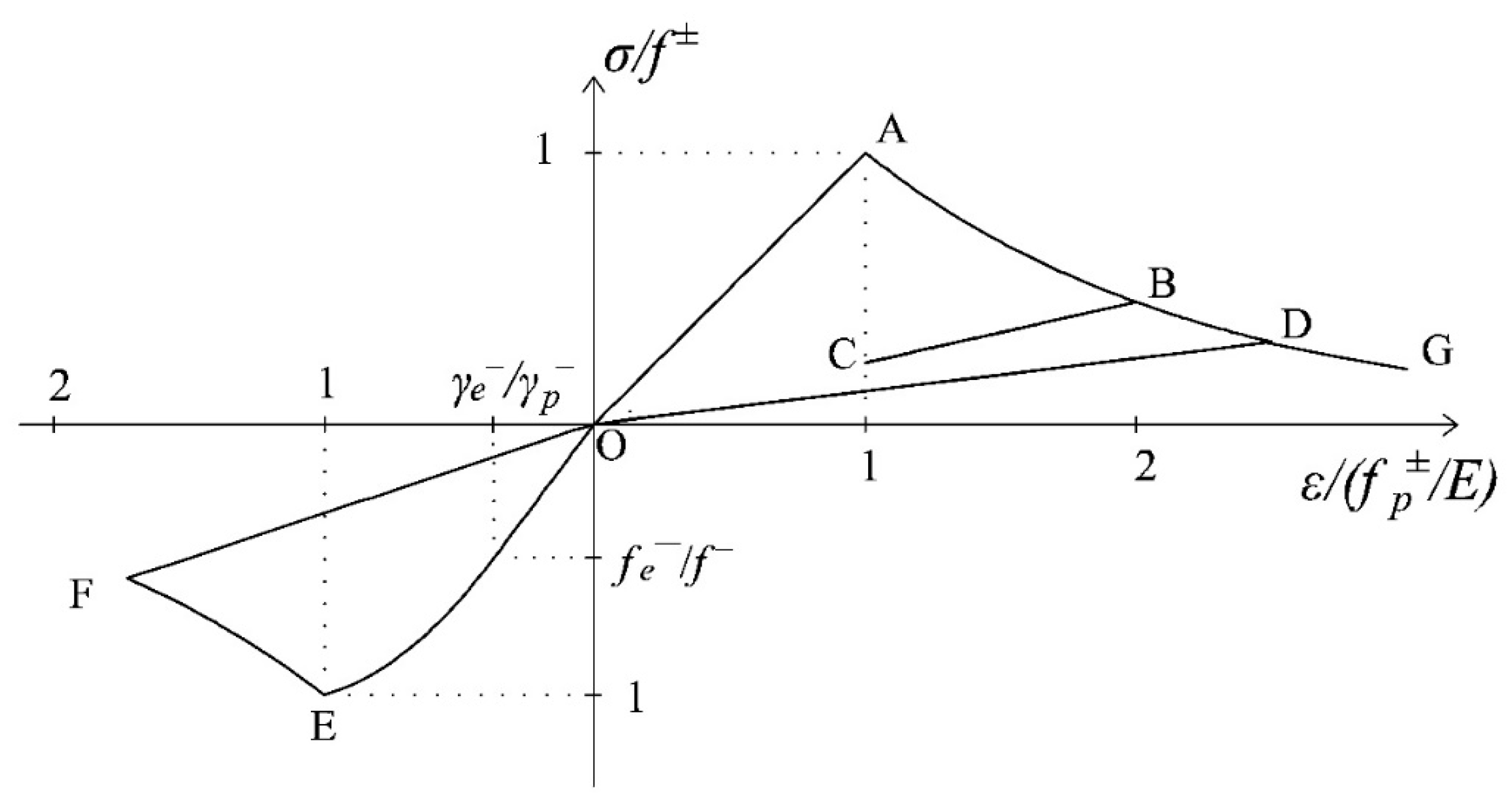
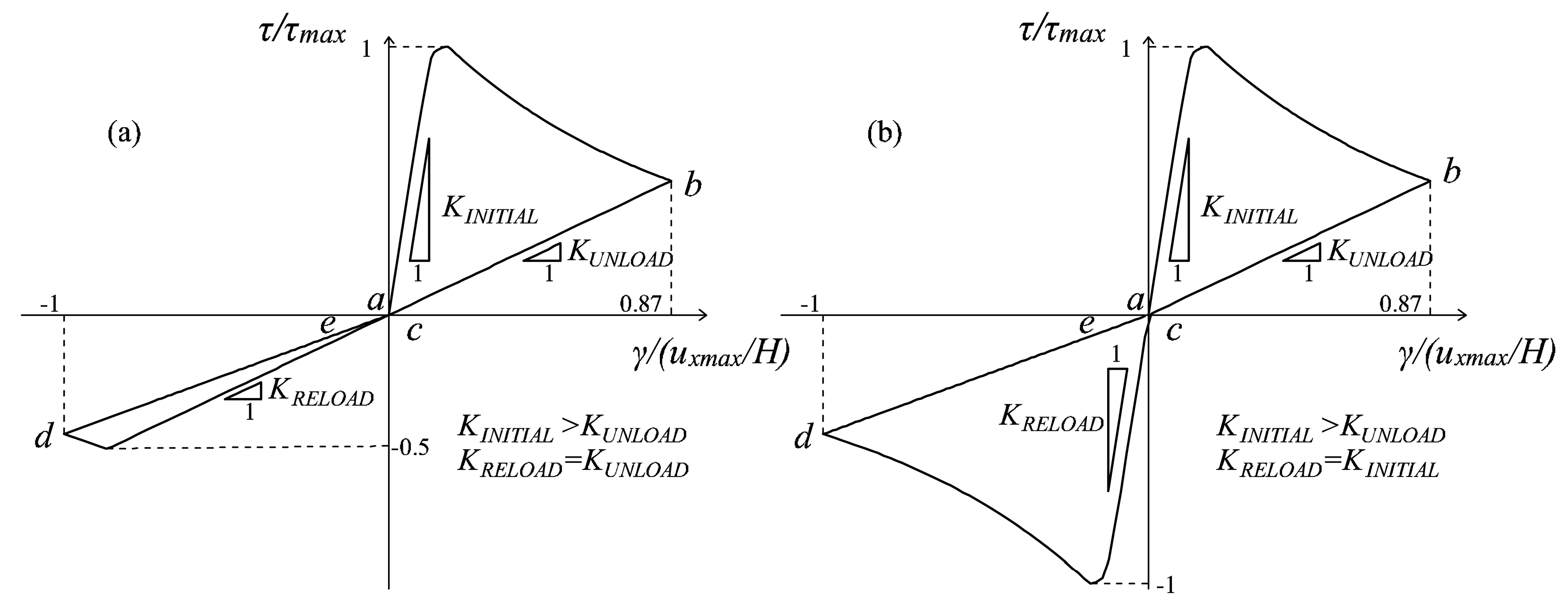
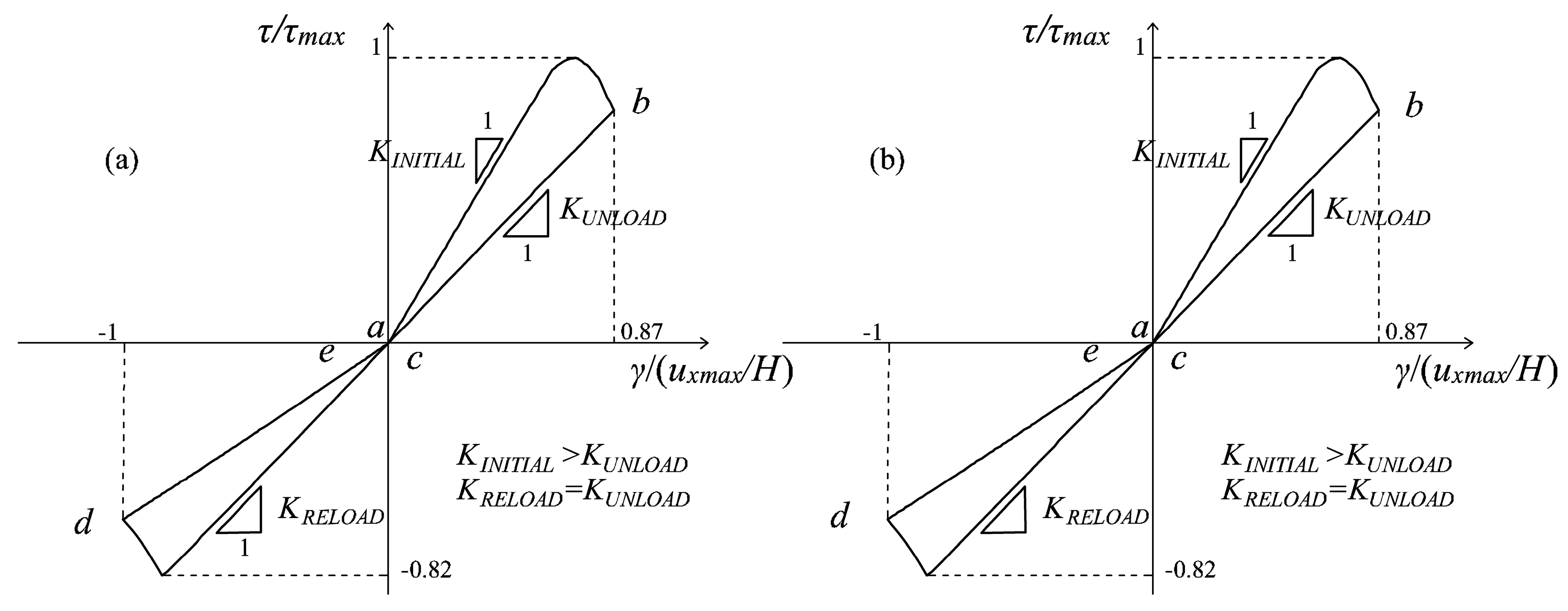

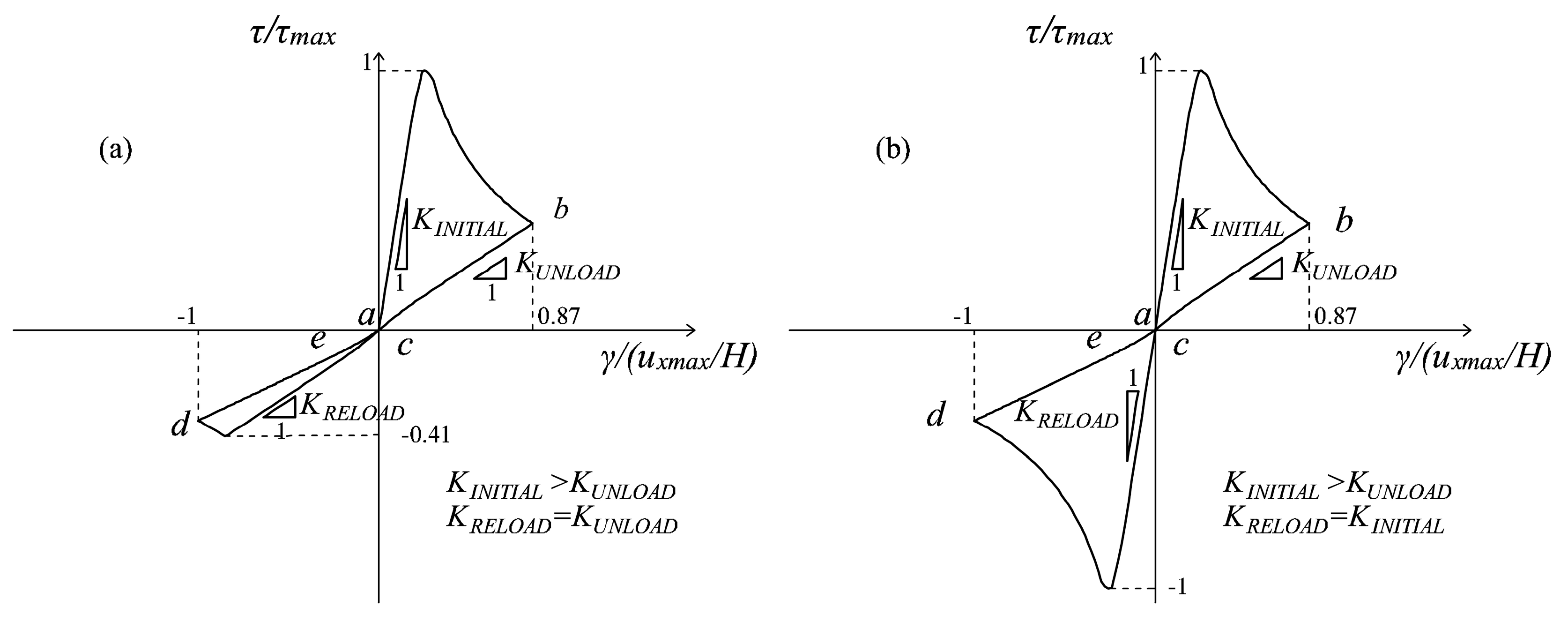

| Load increment n = 0: |
| Set r+n = r+0, r−n = r−0 (definition of r±0 from Equation (35)), d+n = 0 and d−n = 0. |
| Load increment n: |
|
| Load increment n = 0: |
|
| Load increment n = 1: |
|
| Load increment n: |
| Load increment n = 0: |
|
| Load increment n = 1: |
|
| Load increment n: |
|
| E (MPa) | ν (-) | f+ (MPa) | f− (MPa) | γe+ (-) | γp+ (-) | γe− (-) | γp− (-) | Gf+ (N/mm) | Gf− (N/mm) | fb−/f− (-) |
|---|---|---|---|---|---|---|---|---|---|---|
| 1540 | 0.2 | 0.13 | −3.9 | 1 | 1 | 0.5 | 1.3 | 0.1 | 10 | 1.15 |
© 2017 by the authors. Licensee MDPI, Basel, Switzerland. This article is an open access article distributed under the terms and conditions of the Creative Commons Attribution (CC BY) license (http://creativecommons.org/licenses/by/4.0/).
Share and Cite
Cervera, M.; Tesei, C. An Energy-Equivalent d+/d− Damage Model with Enhanced Microcrack Closure-Reopening Capabilities for Cohesive-Frictional Materials. Materials 2017, 10, 433. https://doi.org/10.3390/ma10040433
Cervera M, Tesei C. An Energy-Equivalent d+/d− Damage Model with Enhanced Microcrack Closure-Reopening Capabilities for Cohesive-Frictional Materials. Materials. 2017; 10(4):433. https://doi.org/10.3390/ma10040433
Chicago/Turabian StyleCervera, Miguel, and Claudia Tesei. 2017. "An Energy-Equivalent d+/d− Damage Model with Enhanced Microcrack Closure-Reopening Capabilities for Cohesive-Frictional Materials" Materials 10, no. 4: 433. https://doi.org/10.3390/ma10040433
APA StyleCervera, M., & Tesei, C. (2017). An Energy-Equivalent d+/d− Damage Model with Enhanced Microcrack Closure-Reopening Capabilities for Cohesive-Frictional Materials. Materials, 10(4), 433. https://doi.org/10.3390/ma10040433







